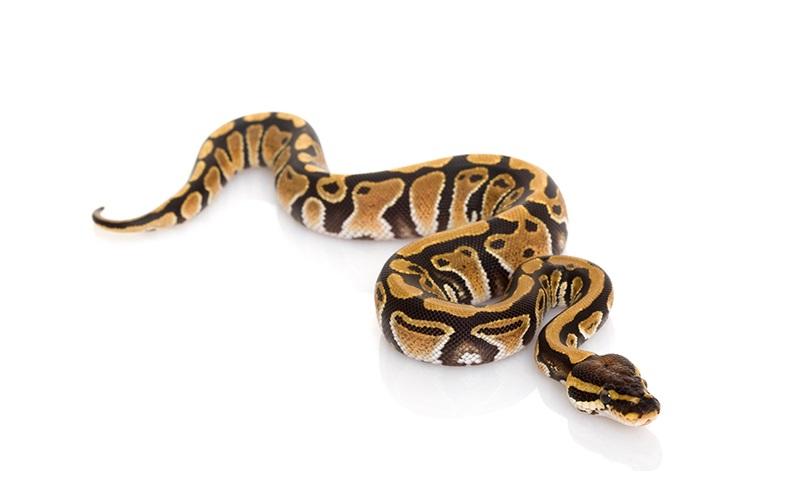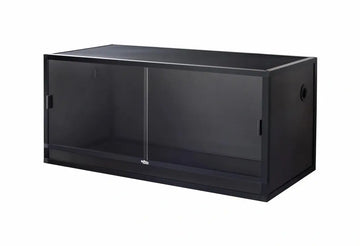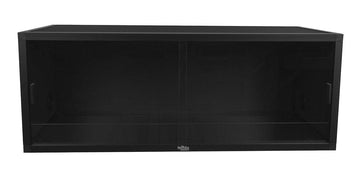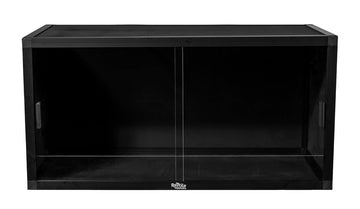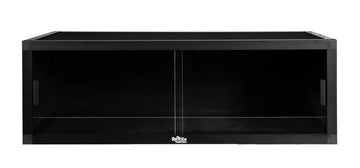Table of Contents
Introduction
Ball pythons (Python regius) are 3-5’ long, crepuscular, semi-arboreal snakes native to central and western Africa. They prefer semi-arid grasslands, forests, and fields for habitat. Although they are frequently found in burrows, they are known to hunt in trees.
Ball pythons have thick, muscular bodies and peanut-shaped heads covered in smooth scales. Wild-type (“normal”) ball pythons have a brown and black pattern outlined by white, with a pale belly. However, thanks to captive breeding efforts, ball pythons are now available in many other colors and patterns.
Ball pythons are among the most common pet snakes in the US due to their hardiness, manageable size, docile nature, and ease of captive breeding. With good care, they are capable of living 30 years or more.
Enclosure
When it comes to housing ball pythons, many people opt for 40 or 75 gallon tanks. However, based on our experience, we suggest a 48”L x 24”W x 24”H enclosure for these snakes. It's important to note that some snakes may become stressed in larger spaces, so providing hiding spots is crucial regardless of the size of the enclosure. Ultimately, the best living conditions for ball pythons will depend on a variety of factors, including their individual needs and preferences.
Can ball pythons be kept together?
We do not recommend cohabitating (keeping multiple snakes in one enclosure) since ball pythons are not a social species, and keeping them together can cause unnecessary stress. It can also cause accidents at feeding time.
How to quarantine a ball python
When you bring home a new pet reptile, it’s best practice to quarantine it first, especially if you own other reptiles.
Quarantine is the practice of isolating animals that have arrived from elsewhere or been exposed to infectious or contagious disease.
Even if you don’t have other reptiles, quarantine is still essential because it allows you to closely monitor your snake for signs of illness and administer treatment. You can use your ball python’s long-term enclosure for quarantine or a large plastic tub. Tubs are inexpensive and easy to clean, making them the go-to option for quarantine.
Here are some general rules for quarantining your ball python:
- Keep the snake in a different room from other reptiles, if possible.
- We suggest using different equipment for your new ball python and washing your hands thoroughly between handling other animals.
- Thoroughly disinfect the enclosure often; we suggest doing this about one time per week.
- If needed, get the ball python checked by an experienced reptile veterinarian and treated for parasites.
- Monitor your new pet closely and watch for any symptoms of illness or disease.
- Check your snake and its water bowl closely for mites, especially if the snake is soaking. If you do find mites, treat them accordingly.
Lighting
Do ball pythons need UVB?
While ball pythons can survive without UVB lighting, we recommend providing it, if possible. UVB lighting helps give a clear day/night cycle, provides all of the vitamin D your pet needs, strengthens the immune system, facilitates better digestion, and other benefits.
The best UVB bulbs for ball pythons housed in a 48” x 24” x 24” terrarium are:
For best results, house the UVB bulbs in a reflective fixture. Position the lamp on the same side of the terrarium as the heat lamp, about 9-11” above the basking area if over the mesh, and 12-14” above the basking area if not.
UVB is blocked by glass and plastic, so placing the terrarium in front of a window doesn’t count as “free UVB” — in fact, it can make your terrarium too hot due to the greenhouse effect. Don’t forget to replace your bulb about every 12 months!
We suggest leaving lights on for about 8-12 hours daily to follow a natural day-to-night cycle. You may wish to adjust this for seasonal changes, such as running the lights longer during the summer. All lights should be off at night.
How to measure UVI
The strength of a lamp’s UVB output is measured in UV Index or UVI. Coincidentally, this is the measurement that the World Health Organization uses to estimate the risk of skin damage from exposure to solar radiation. The best way to measure UVI in your ball python’s enclosure is with a Solarmeter 6.5.
To use the Solarmeter, hold the device vertically at the height of the basking surface, with the lens pointing directly up at the lamp. Ball pythons should have a basking UVI between 3.0-4.0, with UVI everywhere else in the enclosure being lower. Although the previous section recommends a basking distance, note that factors such as the density of your terrarium mesh and the hood you are using for your UVB lamp will affect the exact space needed.
Heating
The best temperature for ball pythons
Like other reptiles, ball pythons are cold-blooded, which means they rely on external temperatures to manage their body temperature and metabolism. A reptile’s enclosure should offer a range of temperatures to allow them to thermoregulate effectively. To ensure your ball python is healthy and comfortable, provide them with a habitat that offers a range of temperatures for effective thermoregulation. In particular, we find that the enclosure should have a warm and cool side, with a temperature range of 90-95°F for the warm side and 76-80°F for the cool side. We also suggest placing hides on both sides of the enclosure.
Overhead heating methods, such as Halogen bulbs, are recommended to achieve and maintain these temperatures. You may also use alternative methods like under-tank heating or radiant heat panels.
It is essential to regulate and monitor the temperature of the heating method chosen. You can use a thermostat or dimmer switch to control the heat output. You should conduct regular temperature checks to ensure that everything is functioning correctly. We recommend using an infrared thermometer and a digital thermometer to monitor enclosure temperatures accurately.
Providing your ball python with the appropriate temperature range will ensure that your pet is healthy, comfortable, and able to carry out necessary biological processes effectively.
Humidity
Best humidity levels for ball pythons
Appropriate humidity levels are crucial for ball pythons' health and well-being. Maintaining an average humidity level between 45-75% is recommended, with levels fluctuating slightly lower during the day and higher at night.
To ensure that your ball python has access to sufficient humidity, it is a good idea to provide a third humid hide lined with moistened sphagnum moss. This will allow your snake to regulate its humidity levels as necessary.
We recommend using a digital hygrometer to monitor the humidity level in the enclosure accurately. This device will allow you to keep track of the humidity levels and adjust as needed to ensure your ball python is in a comfortable and healthy environment.
One effective method to increase humidity levels in your ball python's enclosure is by misting it with a spray bottle once or twice a day. Misting the enclosure first thing in the morning and again at night if necessary is recommended. Another way to maintain humidity levels is by mixing water directly into the substrate. This will help to retain moisture and prevent the enclosure from becoming too dry.
How to create a humid hide for your ball python
We suggest adding a third humid hide in addition to the warm and cool hides, which should be placed towards the middle to cool end of the enclosure. Providing your ball python with access to a humid hide is a great way to ensure your ball python will be able to stay well-hydrated and shed more easily. This hide should function as a humid burrow to which your ball python can retreat whenever it needs a bit of extra moisture.
There are various options for purchasing a humid hide, such as the Zilla Rock Lair and the Exo Terra Snake Cave. These products are fully-enclosed and easy to clean. Alternatively, you can make your humid hide using a Tupperware container with a hole cut out for an entrance. Whether you purchase or create your humid hide, you should line it with a moistened paper towel or sphagnum moss.
If you use paper towels, you should replace them every 1-3 days to ensure it stays clean. If you use sphagnum moss, replace it every 2-4 weeks. By providing your ball python with a humid hide and regularly maintaining it, you can help ensure your pet stays healthy and comfortable.
Substrate
Naturalistic Options
Choosing a suitable substrate is essential when creating a comfortable and healthy habitat for your ball python. A great option is to provide a thick layer of natural substrate or bedding, which can offer cushioning and help maintain humidity levels while enhancing the enclosure's overall appearance. We recommend the following commercial substrates for ball pythons:
Substrate mixes are also a great option. You can mix several commercial substrates or create a mixture using a combination of organic topsoil, play sand, and moss. Other self-made mixture options are possible, and you should research the subject thoroughly before creating your custom mix.
Layering clean, chemical-free leaf litter on the substrate can also help with humidity.
Ideally, the substrate should be at least 4” deep and completely replaced every 3-4 months. Remove poop and urates daily, along with any contaminated substrate.
Paper Towels
While various substrate options are available for ball python enclosures, some keepers prefer to use simpler substrates such as paper towels. This can be an effective and easy-to-maintain option for keeping your snake's enclosure clean and is an especially great option when your snake is still in quarantine.
However, remember that using paper towels as a substrate requires more frequent replacement than other options. Paper towels can quickly become soiled and develop mold if left unchanged for too long. Therefore, we recommend regularly replacing the paper towel substrate to keep your ball python's enclosure clean and prevent mold growth.
Ultimately, the choice of substrate for your ball python's enclosure will depend on your personal preferences and your pet's needs. Regardless of which substrate you choose, you must maintain it properly to ensure your ball python stays healthy and comfortable.
What to know about cleaning a ball python enclosure
Replacing your ball python’s substrate is a good time to give the entire enclosure a good cleanout. Here are some general steps to follow:
- Remove your snake from the enclosure and put it inside a temporary, escape-proof holding container. This container should offer a hide, a small water bowl, and a thin layer of the old substrate from the enclosure for the snake’s comfort.
- Remove all substrate and decor.
- Vacuum and wipe down the enclosure to remove leftover particles.
- Apply a reptile-safe disinfectant to the floor and walls of the enclosure and let it sit for the disinfectant’s recommended contact time.
- Meanwhile, soak branches, rocks, hides, and other decor items in a disinfectant rated for porous materials for the recommended contact time.
- If required, rinse the enclosure and the accessories with clean water to remove disinfectant residue. Allow everything to dry.
- Pour new substrate into the enclosure. Mix in water until uniformly moistened but not wet.
- Arrange décor. If your ball python is easily stressed by change, put everything back where it was before.
- Reintroduce your snake to the clean setup.
Several veterinary-grade disinfectant options are available that are effective for both porous and nonporous materials, such as Chlorhexidine, F10SC, and CleanBreak. It is essential to carefully follow the instructions on the packaging to ensure safe and proper use. Alternatively, you can use diluted bleach for disinfecting. For porous materials, we suggest a 1:10 dilution, while for nonporous materials, we recommend a 1:50 dilution.
Can bioactive work for ball pythons?
Bioactive vivariums can be a good housing choice for ball pythons because they are conducive to higher humidity levels and are generally more attractive than other options. It is especially nice if your snake likes to hide most of the time. Bioactive vivariums have the additional benefit of eliminating the need for total cleanouts, and a healthy vivarium always has a fresh, earthy aroma.
Bioactive enclosures do come with some downsides. We recommend waiting at least one month to establish the enclosure before introducing your snake to it. The plants you use need to be sturdy and strong enough to avoid being crushed by the snake as it explores the habitat. Bioactive is usually more expensive to set up in the short term. CUC (Clean Up Crew) organisms may occasionally escape; maintenance such as plant care and occasional partial soil replacements are still necessary.
If you want to put together a bioactive setup for your ball python, you will need all of the supplies recommended in this article, plus a few more things:
- bioactive-ready substrate mix
- clean leaf litter
- sturdy live tropical plants that can withstand occasional snake traffic
- 6500K LED or fluorescent grow lamp, spanning most of the enclosure’s length
- tropical CUC organisms to maintain the soil
While it’s possible to mix your temperate bioactive substrate, if this is your first attempt at bioactive, you’re most likely to have success if you use a pre-mixed bioactive substrate available commercially, such as through Bio Dude or Josh’s Frogs.
Good options for CUC for a bioactive ball python vivarium include dwarf white isopods, powder orange/blue isopods, and springtails.
Décor
How to decorate a ball python terrarium
We have found that providing environmental enrichment for your ball python can significantly improve its quality of life by keeping it stimulated and engaged. Adding carefully selected décor items can encourage natural behaviors and exercise, leading to a happy and healthy pet.
As previously mentioned, providing multiple hides is recommended, with one placed on the warm side and one on the cool side of the enclosure, along with a humid hide, if possible. We find that ball pythons will gladly use branches to climb on, and adding other items, such as fake plants or cork bark, can create a more naturalistic and stimulating environment. Be sure to avoid items with sharp edges. Some great options to include in your enclosure are:
Live plant options for ball pythons
Because ball pythons are heavy-bodied, they easily accidentally crush live plants in their enclosure. This means that you need to be careful in selecting plants that are the most likely to resist occasional trampling. Here are some plants that are robust and do well in a moderately humid, moderately-lit environment:
- Dracaena
- Ficus
- Peperomia
- Philodendron
- Pothos
- Schefflera
- Spider plant
Larger, older plants are more expensive to buy, but they are also sturdier and more likely to survive your ball python.
Food
What to feed to a ball python
Ball pythons are carnivores, meaning they must eat whole animal prey for proper nutrition. Here is a basic feeding schedule based on snake weight:
- Hatchlings (up to 5 weeks old) — every 5 days
- Juveniles <200g — every 7 days
- Juveniles 200-350g — every 7-10 days
- Juveniles 350-500g — every 10-14 days
- Subadults and adults 500-1500g — every 14-21 days
- Adults >1500g — every 28-56 days
Prey items should be around 10% of the snake’s weight and no more than 1.5x its width at its widest point. Both frozen and live prey can be fed. We do recommend using frozen/thawed rodents when possible, as they are easier to find and store while eliminating the risk of the prey injuring your snake. If you choose to feed live prey, we strongly recommend monitoring your snake during feeding so that you can quickly remove the rodent if needed. Frozen prey should be thawed in a BPA-free plastic bag in warm water until it reaches ~100°F, then use a pair of soft-tipped feeding tweezers to offer it to your snake.
One of the keys to great nutrition is variety, so aside from offering mice and rats, quail and chicks can also be used to add diversity to your snake’s diet.
Where to get feeders for your snake
Most pet stores sell frozen mice and rats in various sizes to feed snakes. This is convenient because you can buy prey one at a time. However, the variety is most likely to be highly limited, and the price per rodent is typically relatively high.
You can purchase feeders from an online breeder for your ball python if you prefer a more convenient option. With the help of the internet, you can access a wide range of prey options. However, it's worth noting that these breeders typically require bulk purchases, resulting in a lower cost per rodent but higher upfront expenses. Moreover, due to the perishable nature of the feeders, shipping costs can be high. We suggest buying several months' worth of supply at once to avoid paying too much on shipping fees.
By utilizing social media, you can often find a local feeder breeder to supply your rodents, and many can offer both live and frozen/thawed. Some keepers choose to breed their rodents. While this is an option, it is work-intensive as you will have rodent enclosures that need regular cleanings.
Why do ball pythons go off feed?
Ball pythons are known for their infrequent feeding habits, often skipping meals and going on long fasts, especially during the same season each year. While this may be concerning, it's important to remember that adult ball pythons can handle long periods of fasting without significant health effects. However, if your python loses 10% or more of its body weight quickly, you should seek veterinary care to ensure it's not sick. On the other hand, juvenile ball pythons should not miss meals too often as they are still growing.
Providing drinking water for ball pythons
Of course, don’t forget a large water bowl for your snake to drink from and soak in! Change the water daily and scrub the bowl with a reptile-safe disinfectant weekly or whenever it becomes soiled.
Handling
How to handle your ball python
Reptiles generally don’t appreciate petting and handling in the same way that dogs and cats do. Ball pythons generally tolerate human interaction pretty well! When picking up your ball python, be gentle and try to pick it up from the side or below rather than from above. Support as much of its body as possible, and NEVER pick it up by its tail, as this can damage its spine!
Taming tips for ball pythons
Ball pythons are usually gentle, so many people think they will be easy to tame. However, this isn’t always the case. Ball pythons are often timid, so you may have to work to gain their trust and be especially careful to create a positive association with themselves. It’s best to encourage the snake to come out of the enclosure and climb onto you on their own, rather than simply grabbing them whenever you’re in the mood for handling. We do not suggest grabbing your ball python out from its hide, as this is a very effective way to make it feel unsafe.
Are you worried about getting bitten? Teach your ball python to tell the difference between food and handling times. One way to do this is by tapping on the front of the enclosure with your fingernails before offering food so the snake associates tapping with food. When it’s handling time, don’t tap. Of course, if the snake still looks coiled and interested, you can use a paper towel roll to gently tap the snake on the head and distract it from thinking about food.
Additional training is very worthwhile for building up your ball python’s confidence.
How to provide enrichment for a ball python
Enrichment is the practice of strategically providing items and activities to encourage a captive animal to exercise natural behaviors. This also helps increase activity, reduce stress, and increase the animal’s welfare.
Here are some ways to provide enrichment for ball pythons:
- Rearrange the enclosure. If total overhauls are too stressful, move one thing occasionally at your snake’s pace. For some individuals, that may be once a month; for others, they might like once a week.
- Puzzle feeders. This can be as simple as placing the snake’s prey in an open box or plastic cup.
- Simulated nest raids. Instead of offering one prey item, place a cluster of much smaller prey (ex: pinky mice or pinky rats) somewhere in the enclosure for the snake to find.
- Supervised exploration time outside of the enclosure. Make sure to keep them away from situations that you can’t get the snake out of.
- “Box of things.” Introduce your snake to a box or bin full of different items of different sizes and textures: branches, pipes, easily-washable plushies, etc.!
Health
When should you take a ball python to the vet?
Dogs and cats aren’t the only pets who need veterinary care — snakes get sick and need professional help like any other pet. If you notice that your snake has any of the following symptoms, make an appointment with an experienced reptile vet right away:
- Noisy breathing
- Mucus discharge from the mouth/nose
- Unexplained weight loss
- Large patches of missing scales
- Discolored belly scales
- Swelling or bumps anywhere on the body
- Sudden, unusually aggressive behavior
Ball Python Resources
*This care sheet contains only very basic information. Although it’s a good introduction, please further your research with high-quality sources. The more you know, the better you will be able to care for your pet!

